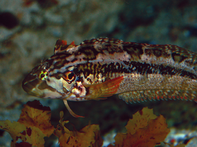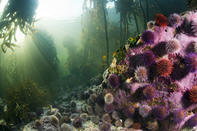The Clan Stuart
Average depth: 6m / Maximum depth: 8m
After a south-easterly gale on November 21, 1914, a 3 500 ton British Turret Steamer carrying coal lost its anchors and sank. Most of the ship is broken up but the engine block and propeller shaft are still visible.

This wreck lies scattered over the ocean floor, almost totally on a bed of sand, and is in some places totally covered by weeds and kelp. Nudibranchs such as the Janolus Capensis are widely found on this wreck as well as Rippled klipfish, Pipefish and lots of Sandgobies which are barely visible on the sand. Brittle starfish, Stephenson’s sea cucumbers and Cape urchins are in abundance. This is a casual shallow wreck dive but take note that the scattered metal on this wreck can influence your compass and thus your sense of direction.
Roman Rock

Average depth: 15m / Maximum depth: 25m
As it isn’t often dived, Roman Rock is rather unspoilt and the sea life is abundant. The marine life here includes, amongst others, playful seals that from time to time come to mingle with the divers. The regular fish life and the invertebrate life includes beautiful Seastars, Basketstars, Brittlestars and Feather stars, and, if you look closely, the most beautiful Nudibranchs. Urchins, anemones and bright coloured Sea fans can also be seen at this spot.
Quarry
Average depth: 7m / Maximum depth: 10m
This reef, which consists of rocky gullies, is situated near Glencairn opposite the quarry on the mountainside. A variety of Sea fans are found here along with Feather stars, numerous reef fish and beautiful Nudibranchs. Typical False Bay marine life can be found on this reef. On the coral itself, be on the lookout for various types of Nudibranchs, octopus and Hermit crabs hiding in their shells.
The A-Frame

Average depth: 5m / Maximum depth: 9m
This part of the reef has, once again, large smooth boulders that at one part form a swim-through in the shape of a big ‘A’. There are also some big crevices where fish hide during the day. On some of the sand patches near the rocks we found a few Longsnout pipefish, Klipfish, Blennies and Sandgobies camouflaging themselves from predators. In almost every hole or crevice you will find either an octopus or a crab looking for something to eat.
Along the sides of the walls are the most beautiful Gasflame nudibranchs, colourful Starfish and bright orange Sea sponges. Sea anemones are present in various colours and seals often come by to say hello. This dive can keep you really busy so remember to keep an eye on the time.
By Johan Boshoff False Bay is so named because many sailors returning from the East used to mistake Cape Hangklip (near Hermanus) for Cape Point. As a result...
False Bay is so named because many sailors returning from the East used to mistake Cape Hangklip (near Hermanus) for Cape Point. As a result... Self drive routes from Cape Town invite visitors to the Mother City to experience the natural splendour, fun activities and scenic attractio...
Self drive routes from Cape Town invite visitors to the Mother City to experience the natural splendour, fun activities and scenic attractio...